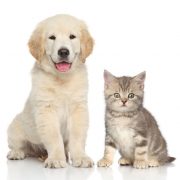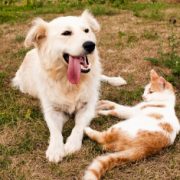Management of urinary disease in cats and dogs
‘In the Spotlight’ features bring together collections of published papers on topics of interest and importance to the veterinary professions.
If you would like to suggest a paper for inclusion in one of our published Spotlight features, or a topic for a future Spotlight feature, please email library@rcvsknowledge.org
Management of urinary diseases in cats and dogs
The last In The Spotlight topic focused on the managment of chronic kidney disease in cats and dogs – this time, the Spotlight is on the management of other urinary diseases:
Calculi, stones, crystals, uroliths
 The occurrence of urinary and ureteral stones, clinical signs, diagnosis, prevention and treatment options including dietary management and other less invasive procedures.
The occurrence of urinary and ureteral stones, clinical signs, diagnosis, prevention and treatment options including dietary management and other less invasive procedures.
-
- Bartges, J.W. (2016) Feline calcium oxalate urolithiasis: risk factors and rational treatment approaches. Journal of feline Medicine and Surgery, 18 (9), pp. 712-722. [This article can accessed via RCVS Knowledge Library Membership, click here]
- Cleroux, A. et al. (2017) Evaluation for association between urolithiasis and chronic kidney disease in cats. Journal of the American Veterinary Medical Association, 250 (7), pp. 770-774. [This article can accessed via RCVS Knowledge Library Membership, click here]
- Lulich, J.P. et al. (2016) ACVIM small animal consensus recommendations on the treatment and prevention of uroliths in dogs and cats. Journal of Veterinary Internal Medicine, 30 (5), pp. 1564-1874. [Available on open access. Accessed 20/4/2018]
- Allen, H.S. et al. (2015) Associations of diet and breed with recurrence of calcium oxalate cystic calculi in dogs. Journal of the American Veterinary Medical Association, 246 (10), pp. 1098-1103. [This article can accessed via RCVS Knowledge Library Membership, click here]
 More references retrieved from CAB Abstracts are available to download.
More references retrieved from CAB Abstracts are available to download.
FLUTD and urinary tract infections
Feline lower urinary tract disease is commonly caused by cystitis, but other aetiologies include urolithiasis, behavioural and dietary conditions. Similarly, urinary tract infections in cats and dogs are frequently presented during clinical consultations, caused by idiopathic cystitis with most cases being associated with stress e.g. changes in the home environment.
-
- Cummings School of Veterinary Medicine at Tufts University (2018). The real danger of FLUTD. Catnip, April 2018. [Available free online. Accessed 20/4/2018]
- Sparkes, A. (2018) Understanding feline idiopathic cystitis. In Practice, 40 (3), pp. 95-101
- Livet, V. et al. (2017) Placement of subcutaneous ureteral bypasses without fluoroscopic guidance in cats with ureteral obstruction: 19 cases (2014-2016). Journal of Feline Medicine and Surgery, 19 (10), pp. 1030-1039. [This article can accessed via RCVS Knowledge Library Membership, click here]
- Caney, S. (2017) Maintenance and treatment of feline lower urinary tract disease. Veterinary Times, 47 (1), pp. 12-14
- Colakoglu, E.C. et al. (2017) Efficacy of single-dose ceftriaxone versus multiple-dose enrofloxacin in dogs with uncomplicated lower urinary tract infection: a randomised clinical trial. Veterinarni Medicina, 62 (3), pp. 125-130. [Available on open access. Accessed 20/4/2018]
- Frohlich, L. et al. (2016) Postobstructive diuresis in cats with naturally occurring lower urinary tract obstruction: incidence, severity and association with laboratory parameters on admission. Journal of Feline Medicine and Surgery, 18 (10), pp. 809-817. [This article can accessed via RCVS Knowledge Library Membership, click here]
- Jessen, L.R. et al. (2015) Effect of antibiotic treatment in canine and feline urinary tract infections: a systematic review. Veterinary Journal, 203 (3), pp. 270-277. [This article can accessed via RCVS Knowledge Library Membership, click here]
- Rose, L. (2014) Canine urinary tract infection. The Veterinary Nurse, 5 (7), pp. 386-389. [This article can accessed via RCVS Knowledge Library Membership, click here]
- Gunn-Moore, D. (2014) Urethral obstruction in feline lower urinary tract disease. Veterinary Times, 44 (6), pp. 6, 10
- Langford Vets Feline Update – FLUTD Management Algorithm; Feline Update Spring 2012 and Feline Update Autumn 2011 [Available free online. Accessed 20/4/2018]
 More references retrieved from CAB Abstracts are available to download.
More references retrieved from CAB Abstracts are available to download.
Urinary incontinence
Two common causes of urinary incontinence include dysfunction of the urethral sphincter (in neutered bitches) and a congenital condition ectopic ureter which is a congenital anomaly of the urinary system, in which the ureteral orifice is inappropriately positioned caudal to the urinary bladder.
Treatment includes surgical correction and hormonal therapy as it is now reported that the cause of urinary incontinence can also be hormone-associated.
-
- Stilwell, C. and Tappin, S. (2016) Approach to canine urinary incontinence. Companion Animal, 21 (12), pp. 692-699. [This article can accessed via RCVS Knowledge Library Membership, click here]
- Reeves, L. et al. (2013) Outcome after placement of an artificial urethral sphincter in 27 dogs. Veterinary Surgery, 42 (1), pp. 12-18. [This article can accessed via RCVS Knowledge Library Membership, click here]
- Forsee, K.M. et al. (2013) Evaluation of the prevalence of urinary incontinence in spayed female dogs: 566 cases (2003-2008). Journal of the American Veterinary Medical Association, 242 (7), pp. 959-962. [This article can accessed via RCVS Knowledge Library Membership, click here]
- Holt, Peter (2011) Understanding canine urinary incontinence. Vet Professionals, Roslin
 More references retrieved from CAB Abstracts are available to download.
More references retrieved from CAB Abstracts are available to download.
Online full-text available to Library members
A range of library membership packages is available and MRCVS vets and RVNs can join the library for a heavily subsidised, annual fee.
Image copyright attribute:
Copyright: fotojagodka / 123RF Stock Photo





Leave a Reply
Want to join the discussion?Feel free to contribute!